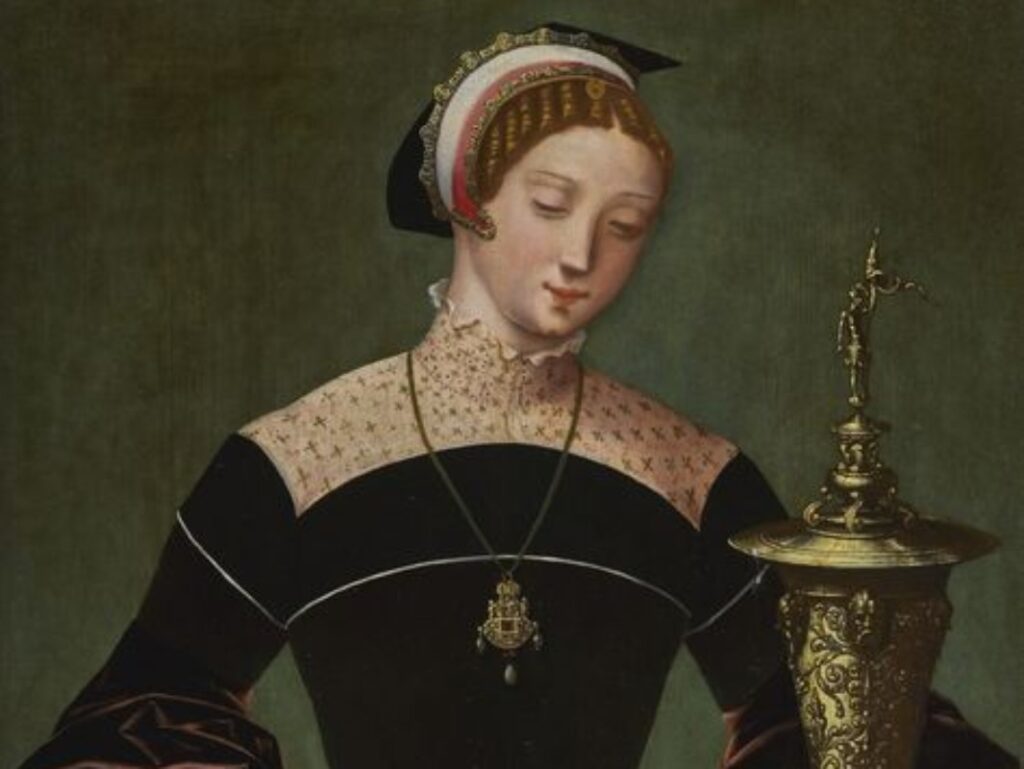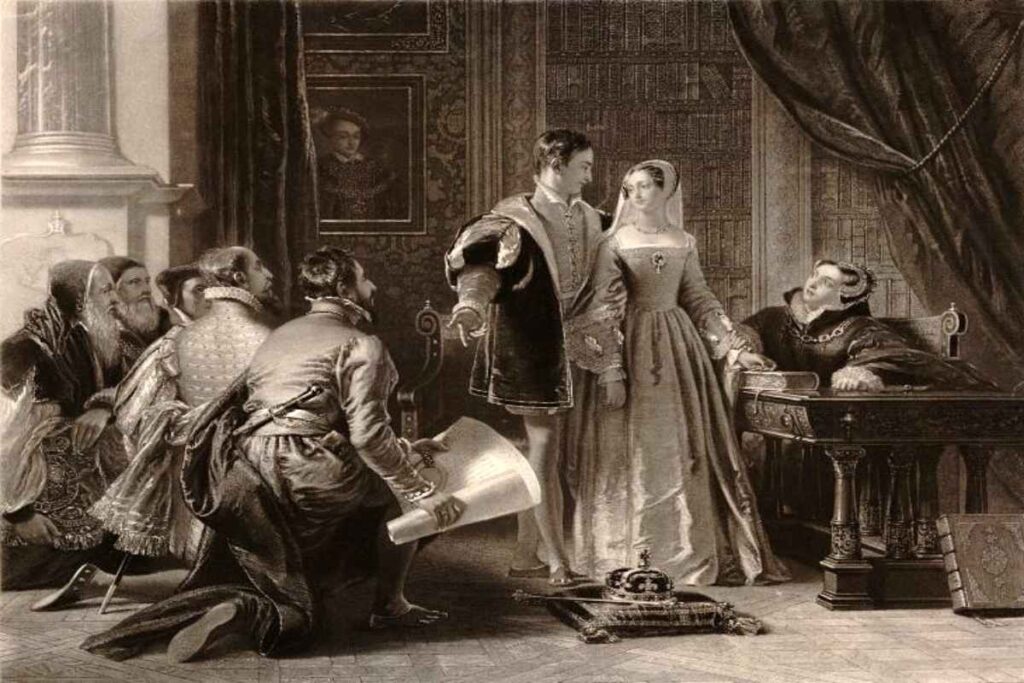In the summer of 1553, the throne of England was forced upon a teenager. Her name? Lady Jane Grey.
Naturally, she wasn’t the next in line to the throne. However, she was thrust into leadership at 16 through a mischievous power play.
A few days after Lady Jane Grey was declared Queen, a wave of uncontrollable political events played out. These incidents ultimately led her to an early grave.
Mary Tudor, her cousin, dethroned Lady Jane Grey. Afterward, she was imprisoned and executed.
The Tudor succession crisis and Lady Jane Grey are one of the most heartbreaking episodes in English royal history.
She became known as England’s Nine Days Queen. Crowned as queen and killed after nine days. She became an innocent victim of some of the most brutal and selfish political chess moves.
The Tudor succession crisis and Lady Jane Grey are one of the most heartbreaking episodes in English royal history. It is a tale of manipulation, betrayal, and ambition gone wrong.
But how sophisticated could a power struggle be to consume the life of an innocent young lady? We are about to find out.
A Childhood of Privilege and Constraint
Born in October 1537, Lady Jane Grey came from the line of Henry VII, who became her great-grandfather. She was also a cousin to King Edward VI and his half-sisters, Mary and Elizabeth.
Though close to the throne, no one, including herself, expected her to sit on it. Yet her parents, Henry Grey, Duke of Suffolk, and Frances Brandon, invested heavily in her education.
By the time she was in her mid-teenage years, she had learned Greek, Hebrew, and Latin — a fact noted by her tutor Roger Ascham. She had all it took to become a highly rated diplomat for the kingdom. For her gender, this was a rare occurrence.
Her intellectual advantage led her to think independently. After exploring some theological knowledge, she fell in love with protestantism.

Despite her independent upbringing, the direction of her life was dictated mainly by others. Her strict parents had a significant influence on her decisions.
Yet, she was considerably satisfied with her life. All she wanted was a quiet and fulfilled life. To an extent, she was on course until politics happened.
A Kingdom in Crisis: Edward VI and the Succession
A Tudor succession crisis was the platform for Lady Jane Grey’s tragic end. It all began with the illness of King Edward VI, who was the only son of Henry VIII.
The 15-year-old protestant king was dying of tuberculosis, according to English Heritage. He had no children to take over from him. His half-sisters became the closest in line.
The eldest, Mary Tudor, was Catholic. Her denomination was a problem for the Protestant Reformation that Henry had begun.
On July 10, the day Lady Jane Grey was to be declared as the new queen, her face lacked the expected excitement.
Though Elizabeth was protestant, she was disqualified after being declared illegitimate by Henry VIII’s will. The king makers were in a fix until one of them came up with an unusual idea.
His name was John Dudley. He was the Duke of Northumberland, the most powerful figure in Edward’s court.
Lady Jane Grey was married to his son Guildford Dudley. Her ascension to the throne will benefit the Dudley family.
So, he approached the king with his plan. Speaking convincingly, he got the sick king to alter his succession plan in favor of Lady Jane Grey, a fellow protestant.
After Edward died on July 6, 1553, Dudley acted quickly. He arranged the declaration ceremony, the event that led Lady Grey to become one of the tragic queens of England.
A Reluctant Queen
On July 10, the day Lady Jane Grey was to be declared as the new queen, her face lacked the expected excitement. But the event went on nonetheless. The Tower of London, the traditional site for the unveiling of prospective Kings and Queens, was packed full.
The designated royal official read aloud the formal proclamation of the new queen’s name and right to rule. Trumpeters sounded their instruments. Stewards raised the banners that bore the royal arms.
Mary Tudor wrote the Privy Council, the leaders of the king’s advisors. On July 19, 1553, 9 days after Lady Jane Grey was declared queen, they gave Mary Tudor their full support.
But the mood remained sober. The thousands of attendees at the venue were subdued by doubt. It didn’t take long before their mixed feelings were validated. Some nobles in the kingdom refused to recognize her claim to the throne.
They instead aligned with Mary Tudor, the rightful heir by Henry VIII’s will and the daughter of the beloved Queen Catherine of Aragon. As soon as Grey’s proclamation was made, the famous Mary Tudor vs Lady Jane Grey battle began.
Nine Days of Power
The intriguing history of Lady Jane Grey’s life had its most memorable moments in the nine days after she was declared Queen. Afterward, Jane Grey had a big decision to make. Should she, in line with the advice of John Dudley, name her husband as king?
She declined.

The move required deliberation by Congress, a process that the circumstances did not allow. Instead, she opted to make him Duke of Clarence.
Despite the disappointment from her refusal, John Dudley had more important issues to deal with. Jane Grey’s hold on the throne was still shaky.
John Dudley knew that for his succession plan to work, he had to stop Mary, whose popularity was growing not just among a section of the nobility but also among the commoners.
The young prisoner resumed her studies on Protestantism. In line with her devotion, she wrote letters and prayers.
He marched north to Framlingham to disrupt her rally, which had attracted thousands of notable personalities. These included people who had initially backed Lady Jane Grey.
Prominent among this growing list of defectors was Edward Mone, King Edward’s tax collector. His support meant that Mary had control over the treasury.
From her base in Framlingham, Mary Tudor wrote the Privy Council, the leaders of the king’s advisors. On July 19, 1553, 9 days after Lady Jane Grey was declared queen, they gave Mary Tudor their full support.
Before Dudley could get to Mary Tudor, she was Queen. Lady Jane Grey was quietly deposed and confined within the Tower of London, the same place where she was proclaimed queen.
Imprisonment and Trial
Upon assuming rulership, Queen Mary decided to show her cousin mercy. Grey was just a pawn in a game of political chess who had no intention of contesting for the throne.
She ordered that Grey be locked under guard in the Tower. There, the young prisoner resumed her studies on Protestantism. In line with her devotion, she wrote letters and prayers.
But things were about to get even worse.
The friction between Catholics and Protestants worsened. After Mary decided to marry the Catholic son of the Spanish Emperor Charles V, an insurrection began.
Mary began to view Lady Jane Grey as a potentially dangerous personality who might benefit from the uprising.
Sir Thomas Wyatt, a prominent figure in the English Kingdom, was provoked. The former Sheriff of Kent viewed the marriage as not only a threat to English sovereignty but also a desecration of King Henry’s Protestant legacy and vision.
He mobilized an army of over 3,000 men, according to the Kent Archaeological Society, and staged the Wyatt Rebellion. His aim? Stop the planned marriage and perhaps unseat the new Queen, restoring the kingdom to Protestant hands.

Wyatt received help from Jane Grey’s father, Henry Grey. This alliance brought more trouble for the imprisoned teenager.
In the midst of this rebellion, Mary began to view Lady Jane Grey as a potentially dangerous personality who might benefit from the uprising.
Queen Mary, under pressure from her advisors, tried Grey for treason in November 1554. Knowing that death was her inevitable fate, she pleaded guilty.
The Lady Jane Grey Execution
After hesitating to carry out Lady Jane Grey’s sentence, Mary Tudor finally sanctioned the execution. On February 12, 1554, soldiers led the deposed teenager to her death. Due to her status as a member of the royal family, her execution wasn’t public.
The 17-year-old was killed before her husband, Guildford. Both were allowed to save their lives by renouncing Protestantism and converting to Catholicism. But trust the deeply convicted Lady Jane Grey to decline the offer. Her husband did the same.
The reluctant Queen Mary had no other option than to get rid of them in line with the recommendation of the Privy Council. Before her death, Lady Jane Grey made a short speech.

With dignity and composure, she affirmed her faith and explained that she never desired the crown. After resting her head on the execution block and before the axe fell on her, she made one more utterance. “Lord, into thy hands I commend my spirit.”
The weapon of death landed on her shortly after, ending England’s shortest reign.
Legacy: A Symbol of Innocence and Betrayal
The Lady Jane Grey legacy lives on. Her memory remains cherished in the hearts of future generations of English people.
To the Protestants, she became a martyr, a symbol of unwavering faith in God. Her letters from the Tower of London were later published as devotional texts—a source of strength to the troubled and helpless.
Her tragic death has been relived in plays, poems, and paintings.
On the political side, the Lady Jane Grey betrayal remains an enduring lesson. Innocent people can be caught in the web of other people’s ambitious schemes. In the case of the Tudor power struggles, it was Lady Jane Grey’s family that dragged her to her unfortunate death.
But she died with her dignity intact.
Forever, she remains a symbol of intelligence, bravery, purity, sacrifice, and fidelity to her faith whose life was destroyed by forces beyond her control.
Sources and Further Reading:
- Mary Tudor’s Rise to the Throne → English Heritage (2022: “England’s First Official Queen”)
- The Wyatt Rebellion → Kent Archaeological Society (“Was Sir Thomas Wyatt Able to Draw on a Culture of Rebellion in Kent in 1554?”)
- Lady Jane Grey’s Nine-Day Reign → European Royal History (2019: “Lady Jane Grey, Queen of England: Part II”)

